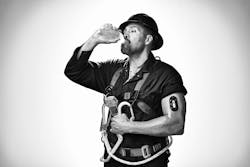Wearable Can Prevent Workers from Dehydration
Industrial athletes, which is another name for an employee whose work requires manual labor, is now able to find some protection from dehydration.
Researchers at UMass Amherst partnered with Epicore Biosystems to validate Connected Hydration, a new wearable sweat and hydration monitor.
Connected Hydration is designed for people in occupations that require a lot of intense, physical activity, often in hot, humid conditions while wearing personal protective equipment. These environments put workers at risk for dehydration and work accidents.
AJ Aranyosi, chief digital officer and co-founder of Epicore Biosystems, explains that 2% fluid loss by body weight results in cognitive decline. “When you start to look back through the literature, the root cause of some of these accidents that do occur in industry is heat exhaustion and heat stroke,” he says, in a statement. “Right now, a lot of the national worker safety guidelines put out generic recommendations based on weather conditions and based on an average person, [but] there’s no such thing as an average person. The amount of sweat people will produce, the composition of the sweat—it varies from person to person.”
The wearable empowers workers to proactively combat the detrimental effects of dehydration and heat exposure through behavioral insights and better understanding of their personal sweat and electrolyte losses. The device enables users to monitor their hydration levels based on the volume and composition of their sweat. It is worn on the bicep and contains microchannels and a sensing module that vibrates once the channels fill with sweat to alert the wearer to rehydrate.
“Thirst is a very subjective thing,” says Aranyosi. “We know from decades of studies on athletes that by the time you feel thirsty you’re already somewhat dehydrated. The other thing we know is that, even when people respond to thirst, they tend not to drink enough to fully replenish what they’ve lost. Just responding to thirst doesn’t keep people safely hydrated.”
When wirelessly linked to a cell phone, the platform provides greater insight into sweat’s electrolyte concentrations over time and allows users to log their water intake. It also connects to the cloud to let employers see aggregated employee data to determine if their workforce is safely hydrated or if intervention is needed.
“The gold standard for assessing total body water loss is measuring the difference in a person’s dry weight before and after an activity,” says Mike Busa, director of the Center for Human Health Performance, located in the UMass Amherst Institute for Applied Life Sciences. He explains the level of rigor they used to collect their data to create a truly closed system. This included urine analysis to test for hydration status before the study began, pre-weighed clothes, dry weighing people in clothes of known weight before and after exercise and tracking water consumption and water loss through urination during the test itself.
“We can closely control the temperature in our space and monitor participants with different devices,” says Corinna Serviente, operations manager and senior physiologist at the Center for Human Health Performance. “We put 44 participants in personal protective equipment, like you would see in the field for these industrial workers. We increased the temperature in our room calorimeter to 86℉ and then had participants exercise while wearing several devices that measure core body temperature, heart rate, water loss, and activity level so that we could provide the data necessary for Epicore to develop and test their water loss algorithms in a way that could not be done in field tests.”
“Somebody might sweat enough to lose maybe half a pound or a quarter pound of sweat,” Aranyosi adds. “When you’re trying to weigh somebody who weighs 200 pounds and you’re looking for a difference of a quarter pound, you really have to take every possible source of weight change into account.”
In addition to using dry weight to measure sweat loss, the researchers also captured sweat from the participants using a non-electric version of Epicore’s device called the Discovery Patch. The team also analyzed the electrolyte composition of the sweat using mass spectrometry.
“We want to know: how much sweat is inside the device and how does that map to how much sweat has the person lost over their whole body?” says Aranyosi. “We started this study with our initial best guesses of how to do that translation. As a result of this study, we were able to go back and derive new formulas to be able to map the voltages [from the device], to sweat loss, salt concentration, and ultimately to be able to provide more accurate measurements and feedback.”
